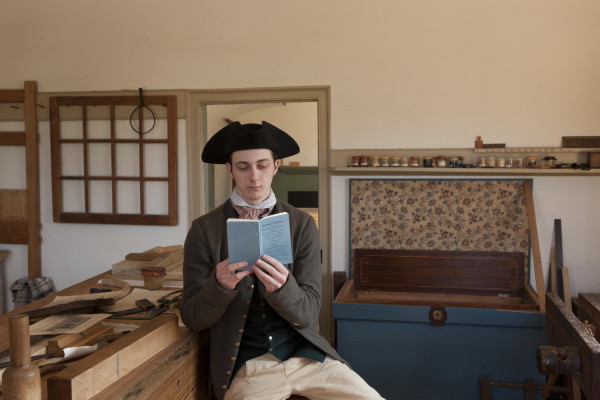 It’s National Book Lovers day! That means it’s time to pour some sweet tea, put your feet up, and delve into a good read.
It’s National Book Lovers day! That means it’s time to pour some sweet tea, put your feet up, and delve into a good read.
We thought it would be fun to get some of Colonial Williamsburg’s talented interpreters to offer up some of their favorites. These folks are experts because they are constantly studying the Revolution, 18th-century life, and their specific areas of interest. So who better to make recommendations?
 Starting along quiet Nicholson Street, I found three coopers hard at work making barrels for the Jamestown Yorktown Foundation. I interrupted Ramona Vogel, journeyman cooper, to ask for her book recommendation. She had to think a moment to get past the specialized books that inform her interpretation of the cooper’s trade 200-odd years ago.
Starting along quiet Nicholson Street, I found three coopers hard at work making barrels for the Jamestown Yorktown Foundation. I interrupted Ramona Vogel, journeyman cooper, to ask for her book recommendation. She had to think a moment to get past the specialized books that inform her interpretation of the cooper’s trade 200-odd years ago.
In the end though, her suggestion ended up being a title from that era: Mary Wollstonecraft’s Vindication of the Rights of Woman, first published in 1792 and available in many different editions today.
“Women’s history wasn’t my initial interest, woodworking was,” says Ramona. But persistent questions from guests about women in the historic trades led her to investigate further. She discovered that issues of discrimination in the workplace were around back then too. “But then it was Wollstonecraft complaining that wealthy women actually had fewer rights than women in the working class.”
Ramona wants young women in particular to understand that people like them were an important part of Williamsburg’s story. Many visit the cooper’s shop thinking a woman wouldn’t have been involved with a trade.
“Well actually, they were,” says Ramona. “There were three women coopers here in Virginia that we know of. You see women in all the trades, and you particularly see them in time of war because the men are going into the military.”
 Walking down Duke of Gloucester Street I next spotted Gerry Underdown, an Actor-Interpreter who was portraying Edmund Pendleton on that particular day. What did he recommend?
Walking down Duke of Gloucester Street I next spotted Gerry Underdown, an Actor-Interpreter who was portraying Edmund Pendleton on that particular day. What did he recommend?
“One of the characters that I portray is Robert Carter III who had a house here in Williamsburg and lived here a number of years. I recommend The First Emancipator by Andrew Levy. That book actually inspired me to do a program.”
His story is a remarkable one. In 1791 Carter, a grandson of the powerful planter Robert “King” Carter, began the process of freeing more than 400 slaves. It was an unprecedented manumission, and it still stands as a powerful counterargument against those who said it couldn’t—or shouldn’t—be done. “After I read it,” said Gerry, “I thought, I have to tell this story.”
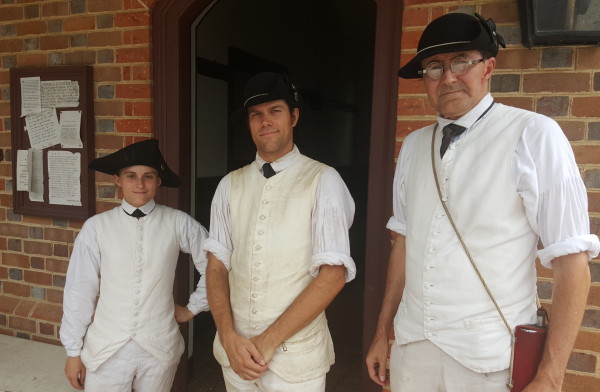 Curious about military life during the Revolution? Katie Watkins, Seth Herbert, and Kent Brinkley from Colonial Wiiliamsburg’s military programs have some suggestions. I tracked them down as they took a break after hauling a cannon back to the Magazine.
Curious about military life during the Revolution? Katie Watkins, Seth Herbert, and Kent Brinkley from Colonial Wiiliamsburg’s military programs have some suggestions. I tracked them down as they took a break after hauling a cannon back to the Magazine.
All three are enthusiastic about Private Yankee Doodle, the Revolution-era diary of Joseph Plumb Martin. (It goes by other titles as well, such as Narrative of a Revolutionary Soldier.)
“It’s funny, its engaging, it’s a wonderful introduction into the life of a soldier,” said Katie. “It’s the most relatable soldier’s memoir that’s commercially available.”
Curious about a different perspective? Seth suggests the perspective of Sergeant Lamb, an Irishman who served in the British army. Robert Graves, best known for I, Claudius, wrote two historical novels based on Lamb’s wartime diaries, Sergeant Lamb’s America and a sequel, Proceed, Sergeant Lamb.
“It’s a great counterpoint to Private Yankee Doodle,” says Seth. “Roger Lamb was a very dedicated British soldier fighting in North America during the American Revolution. It’s a great way to see the opposite side and how the British army viewed being stationed here. He’s dealing with French Canadians, dealing with New Englanders, and dealing Southerners. It’s almost an anthropological point of view, looking at how people from different places act.”
Kent chipped in with a recommendation if you want to know how the war specifically affected Williamsburg. “We all like the first-person accounts, but if you’re looking for more of a historical narrative that’s footnoted and has sources and is written by a historian, then The Revolution in Virginia by John Selby is the book to read. It’s the one we use to train interpreters here.”
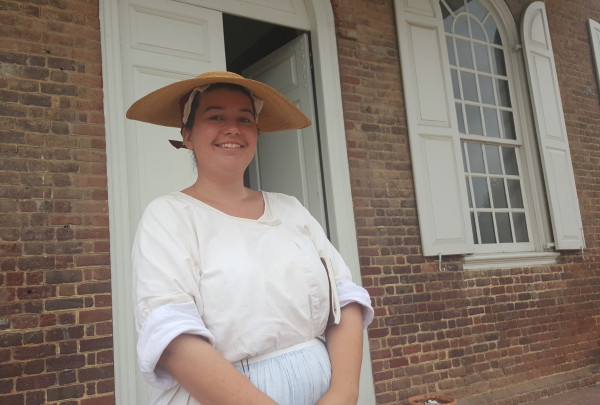 I next approached Orientation Interpreter Amanda Davis, who was helping guests from her perch at the Courthouse. What’s her favorite?
I next approached Orientation Interpreter Amanda Davis, who was helping guests from her perch at the Courthouse. What’s her favorite?
“For me personally, it’s Williamsburg Before and After because the restoration is my favorite part of the history here,” says Amanda. “The buildings are great tools for my interpretation and so many of the guests like to know which ones are original and which ones are reconstructed.”
Williamsburg Before and After tells the story of Williamsburg through its changing landscape as buildings came and went. There are remarkable images of the streetscape a century ago before the Rev. W.A.R. Goodwin and John D. Rockefeller, Jr. began transforming the town.
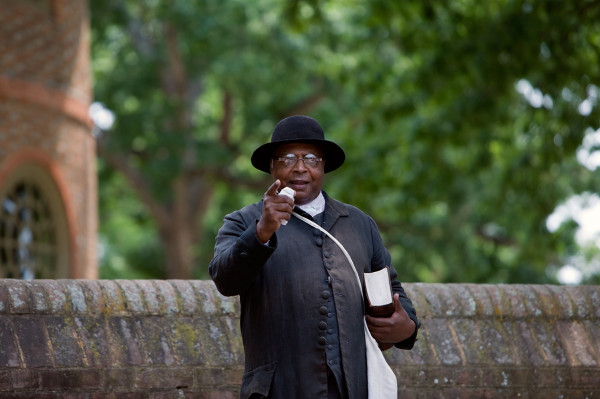 James Ingram, who portrays Rev. Gowan Pamphlet, was making his way across Botetourt Street when he paused to talk to me. James says he really likes The World They Made Together by Mechal Sobel. Why?
James Ingram, who portrays Rev. Gowan Pamphlet, was making his way across Botetourt Street when he paused to talk to me. James says he really likes The World They Made Together by Mechal Sobel. Why?
“It’s about community,” he said. “It covers Williamsburg and the plantations on the outskirts, and it’s a comprehensive look at the integral relationships between the enslaved and the English. They lived in the same places. They had to form relationships. Other books concentrate on individuals, but I like this because it focuses on communities.”
Sobel argues that black and white cultures were not separate, but influenced each other in ways that frequently created something new—in work, home and religion.
That gives me a pretty good list to start with. What about you?
What would you recommend to someone interested in learning more about the Revolution or 18th-century Williamsburg? Share your thoughts in a comment below!
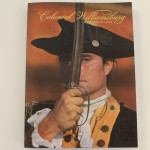
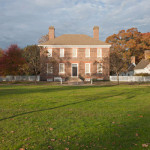
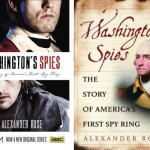
That’s it! I’m going to reserve these at my local library! Thank you for the suggestions! I also enjoyed the fictional story by Avi, titled “Sophia’s War” based on true events in the Revolutionary war of spies and traitors, quite engaging!
Also for children “Scarlet Stocking Spy” and “The Town that Fooled the British” and “Sisters of Scituate Light”!
For a great military perspective, “Diary of the American War, the Journal of Johan Ewald” is one of the best. This Hessian officer was at most of the major engagements of the war and his maps are spot on. The problem is that this book is out of print and can be costly to purchase.
Katie Watkins says
Thankfully, Edwald’s journal is available online for free! It’s a great read, and very much helps to round out the experience of the Revolution.
For kids, “George vs. George: The American Revolution as Seen From Both Sides,” by Rosalyn Shanzer, and for young girls, the Felicity books written as part of the American Girls historical fiction series!
Those are great suggestions. Can’t start too early getting kids interested in our founding history!